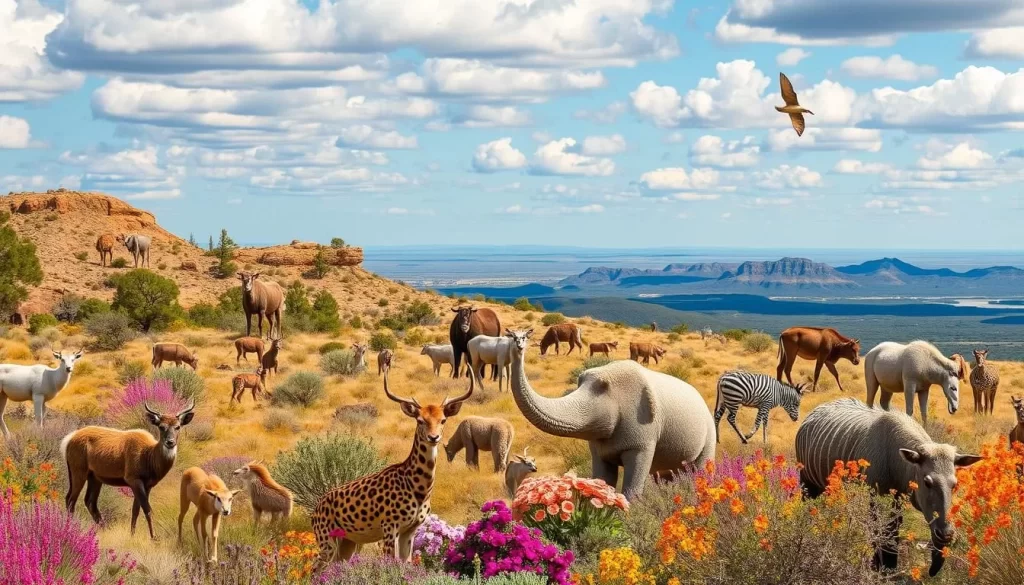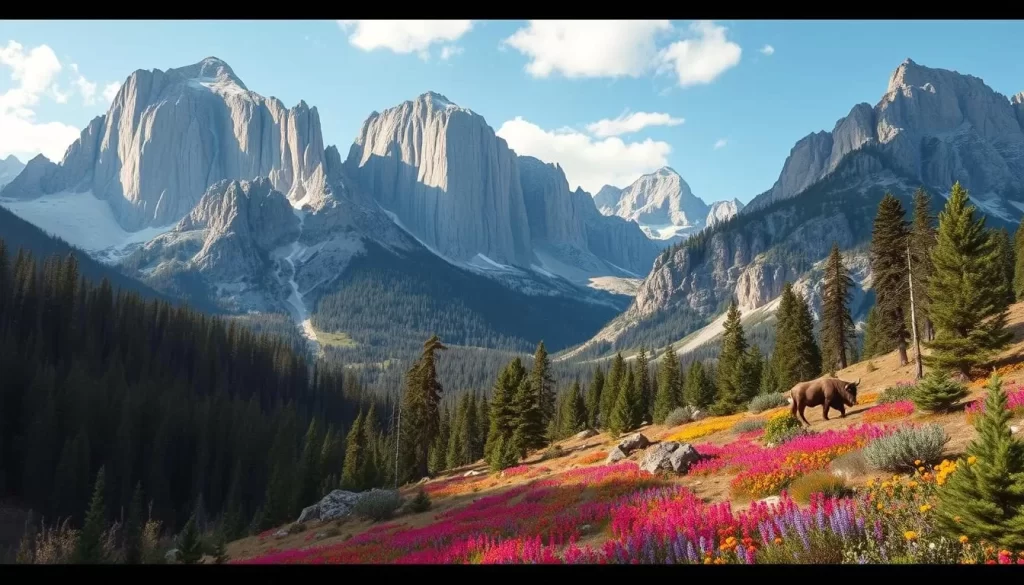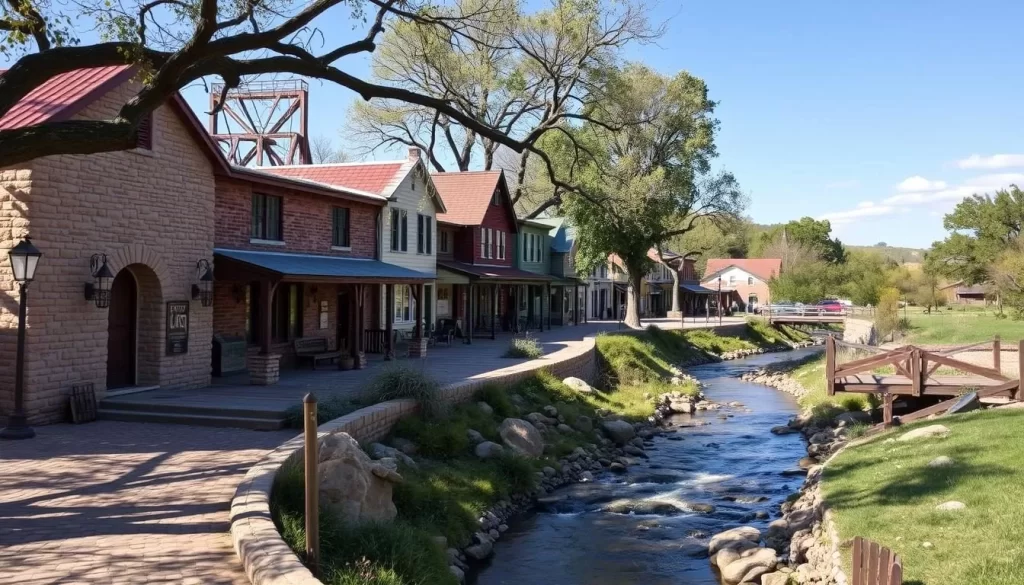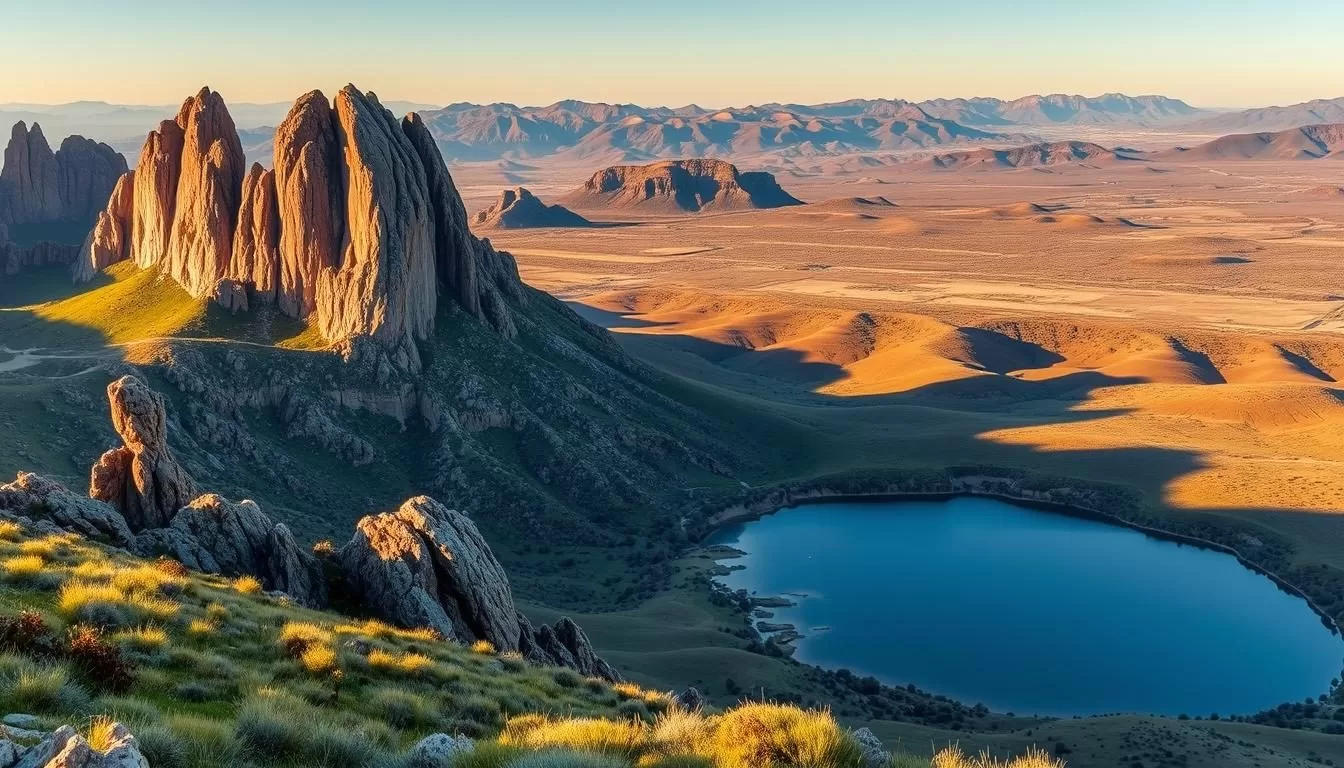✓ Accommodations✓ Flights✓ Rental Cars
The Wichita Mountains Wildlife Refuge in southwestern Oklahoma is a hidden gem that offers a unique blend of natural beauty and diverse wildlife. The refuge spans 60,000 acres, featuring mixed grass prairies, freshwater lakes, and granite mountains.
You can experience the unexpected natural beauty of Oklahoma at this sanctuary, which challenges the common perception of the state as a flat terrain. With its diverse landscape and abundant wildlife, the refuge is an ideal location for various activities.
The refuge’s unique ecosystem and captivating natural areas make it a must-visit destination when exploring Oklahoma. By visiting, you can enjoy an unforgettable journey through one of Oklahoma’s most diverse natural areas.
Discovering the Hidden Gem of Oklahoma
The Wichita Mountains Wildlife Refuge is a hidden gem in Oklahoma that offers a unique blend of history, geology, and wildlife. As you explore this remarkable region, you’ll uncover the rich history and diverse landscape that make it a standout destination.
A Brief History of the Wichita Mountains Wildlife Refuge
Established in 1901, the Wichita Mountains Wildlife Refuge is one of the oldest managed wildlife refuges in the United States. Created to protect species at risk due to overhunting and habitat destruction, it has played a crucial role in the recovery of iconic American species like the American bison, elk, and Texas longhorn cattle. Over the past century, the refuge has been instrumental in conservation efforts, providing a safe haven for these magnificent creatures to thrive.
Geological Features and Landscape
The geological history of the Wichita Mountains stretches back over 500 million years, dating back to the Cambrian period when these ancient granite peaks were formed. The region’s unique landscape has been shaped by volcanic activity, erosion, and tectonic movements, creating a dramatic terrain that stands in stark contrast to the surrounding Oklahoma plains.
| Geological Feature | Description | Formation Period |
|---|---|---|
| Granite Peaks | Ancient granite formations shaped by erosion and volcanic activity | Cambrian period |
| Mixed Grass Prairie | Diverse grasslands supporting a wide range of wildlife | Post-glacial period |
| Freshwater Features | Lakes, rivers, and streams providing habitats for aquatic life | Various geological periods |
![]()
As you explore the Wichita Mountains Wildlife Refuge, you’ll appreciate the diverse landscape of mixed grass prairie, granite outcroppings, and freshwater features that create a variety of habitats supporting the refuge’s remarkable biodiversity. This unique region is a geological wonder worth exploring, offering a glimpse into Oklahoma’s rich natural heritage.
Wildlife Viewing Opportunities

With its unique blend of grasslands and mountains, the Wichita Mountains Wildlife Refuge provides a habitat for a wide variety of wildlife, making it a must-visit destination for nature lovers. The refuge is home to many iconic species, including the American bison, Texas longhorns, elk, and white-tailed deer.
American Bison and Texas Longhorns
The Wichita Mountains Wildlife Refuge is proud to be home to a thriving population of American bison. These majestic creatures have a rich history in the region, having been reintroduced to the area in 1907 when 15 bison were shipped from the Bronx Zoo. Today, all the bison in the refuge are descendants of those original animals. You can also spot Texas longhorns, which are living symbols of American western heritage.
Elk and White-Tailed Deer
The refuge is also a haven for elk and white-tailed deer. These species can be spotted in their natural habitat, particularly during early morning or evening hours when they’re most active. Keep a safe distance, as these animals are an integral part of the refuge’s ecosystem.
Prairie Dogs and Birdwatching
Prairie dogs are another fascinating species found in the refuge. Their intricate burrow systems and social behavior make them a delight to watch. Visit Prairie Dog Town along the main park roads to observe these creatures. The refuge is also a birdwatcher’s paradise, with over 240 species of birds documented. Bring your binoculars to make the most of the excellent birdwatching opportunities.
As you explore the Wichita Mountains Wildlife Refuge, remember to maintain a safe distance from the wildlife, especially the larger mammals like bison and longhorns. This will ensure a safe and enjoyable experience for both you and the animals.
Best Hiking Trails in Wichita Mountains Wildlife Refuge
For outdoor enthusiasts, the Wichita Mountains Wildlife Refuge is a paradise with its numerous hiking trails. The refuge offers a variety of trails that cater to different skill levels and preferences, ensuring that every visitor can find a suitable path to explore the natural beauty of Oklahoma.

Elk Mountain Trail
The Elk Mountain Trail is a 2.3-mile roundtrip hike with a 570 feet elevation gain. The trail is considered moderate, with a steady incline that is not overly difficult. At the summit, hikers are rewarded with panoramic views and the opportunity to explore off-trail among the boulders, including a natural arch.
Crab Eyes Trail
The Crab Eyes Trail is a 3.7-mile roundtrip hike with 406 feet of elevation gain. This trail gets its name from two small boulders that resemble crab eyes perched next to each other. It’s a unique feature that adds to the trail’s charm and makes it a memorable hiking experience.
Charon’s Garden Trail
For those seeking a more rugged experience, the Charon’s Garden Trail is a 4.3-mile roundtrip hike with 482 feet of elevation gain. This trail passes through a valley full of boulders and can offer the sight of a waterfall after rainfall, making it a thrilling adventure for hikers.
Bison Trail and Forty Foot Hole
Combining the Bison Trail with the short Forty Foot Hole trail (1.4 miles roundtrip with 154 feet elevation gain) offers a comprehensive hiking experience. This combination allows hikers to enjoy both canyon views and wildlife habitats, showcasing the diversity of the refuge.
It’s advisable to arrive early or visit on weekdays since many trails share parking lots with limited spaces. Additionally, downloading offline maps before your hike is recommended due to limited cell service throughout the refuge.
Mount Scott: The Crown Jewel of Wichita Mountains

The Wichita Mountains’ crown jewel, Mount Scott, is a must-visit destination. Rising to nearly 2,500 feet, this peak is not only the highest point in the Wichita Mountains Wildlife Refuge but also a haven for those seeking breathtaking views and a glimpse into the region’s geological history.
Driving to the Summit
A scenic three-mile paved road leads to the summit of Mount Scott, offering multiple pull-offs with stunning vistas of lakes, plains, and mountain ranges along the way. You can drive up to the summit, enjoying the picturesque views, and find plenty of parking spaces at the top.
It’s essential to plan your visit according to the access schedule. Vehicles can drive up to the summit on Friday through Sunday afternoons.
Hiking Mount Scott
For the more adventurous, hiking Mount Scott is a moderately strenuous journey that takes approximately three hours round trip. Hikers have exclusive access to the mountain on Saturday and Sunday mornings and must be off the mountain by noon. This allows for a peaceful and safe hiking experience, with constantly changing perspectives as you ascend.
Whether you drive or hike, the panoramic views from the summit are breathtaking, especially during sunrise or sunset when the golden light bathes the landscape. Don’t forget your camera to capture these unforgettable moments.
Lakes and Water Activities

Amidst the rugged terrain of the Wichita Mountains, you’ll discover tranquil lakes that beckon you to explore their waters. The Wichita Mountains Wildlife Refuge is home to several lakes, including Quanah Parker Lake, which offers a variety of water activities.
Quanah Parker Lake and Dam
Quanah Parker Dam, named after the last chief of the Quahadi Comanche tribe, was built during the 1930s as part of the Great Depression’s Work Project Administration program. The dam is a unique structure, with the lake’s water level sometimes revealing the fully exposed dam walls, and occasionally, a waterfall after heavy rainfall.
Fishing and Kayaking Opportunities
Quanah Parker Lake is perfect for kayaking and fishing. You can bring your own kayak, canoe, or stand-up paddleboard to enjoy the calm waters. The lake is home to channel catfish, crappie, largemouth bass, and sunfish. Make sure to have a valid Oklahoma fishing license before you cast your line.
The lakes in the Wichita Mountains Wildlife Refuge not only provide recreational opportunities but also serve as vital habitats for the refuge’s diverse wildlife population. Enjoy the serene water features and appreciate the beauty of the surrounding mountains.
The Holy City of the Wichitas

Tucked away within the Wichita Mountains Wildlife Refuge lies a remarkable site that transports visitors to a different time and place: The Holy City of the Wichitas. This 66-acre replica of ancient Jerusalem is a faithful recreation, featuring meticulously crafted structures that evoke the spirit of Israel during Biblical times.
History and Significance
The Holy City of the Wichitas has its roots in 1920s Oklahoma Sunday school classes, which have grown into an impressive collection of stone structures. You can explore Herod’s Court, Pilate’s Hall, the Garden of Gethsemane, and the Last Supper building, all constructed to transport you back to Biblical times. The site is not just a collection of buildings; it’s an immersive experience that brings the history and significance of Jerusalem to life.
Annual Easter Passion Play
The Holy City is perhaps best known for its annual Easter Passion Play, a deeply moving reenactment that attracts visitors from across the region. This highly dramatized interpretation of Jesus’ life, from birth to resurrection, is a powerful experience. If you’re planning to visit around Easter, witnessing this play is a must. Alternatively, you can enjoy the peaceful atmosphere of the site during other times of the year. A visit to the nearby Prairie Dog Town can complement your experience, offering a chance to observe these social creatures in their natural habitat.
As you explore The Holy City of the Wichitas, you’ll appreciate how this cultural and religious landmark coexists with the natural environment of the Wichita Mountains Wildlife Refuge, creating a unique juxtaposition of spiritual and natural heritage. Whether you’re drawn by the history, the annual Passion Play, or the serene surroundings, The Holy City of the Wichitas is a destination that promises a memorable experience.
Visiting Medicine Park: The Perfect Complement

After exploring the Wichita Mountains Wildlife Refuge, head to Medicine Park, a historic resort town that offers a unique blend of natural beauty and charm. This town, founded in 1908 as Oklahoma’s first resort town, has a rich history that includes visits from notable figures like President Theodore Roosevelt and Al Capone.
Cobblestone Community Charm
The charm of Medicine Park lies in its cobblestone architecture, a distinctive feature that gives the town a quaint, rustic appeal. As you stroll through the town, you’ll appreciate the historic buildings and the picturesque setting, making it an ideal complement to your day of wilderness exploration at the Wichita Mountains.
Dining and Swimming at Bath Lake
Medicine Park offers several dining options, including The Old Plantation Restaurant, Joe Mountain Breakfast Bar, and Small Mountain Street Tacos, where you can sample local cuisine. One of the town’s highlights is Bath Lake, a natural swimming hole formed by Medicine Creek. Open from Memorial Day to Labor Day, it’s the perfect spot to cool off after a day of hiking. You can also consider staying overnight in one of the town’s cabins or tiny houses, making Medicine Park an excellent base for your visit to the Wichita Mountains Wildlife Refuge.
Planning Your Visit to Wichita Mountains Wildlife Refuge
To ensure a memorable visit to the Wichita Mountains, it’s crucial to plan according to the seasonal changes. TheWichita Mountains Wildlife Refugeis open year-round, but the experience varies with the seasons. For the best weather, consider visiting in the spring or fall when temperatures are mild.
When planning your trip, make sure to download offline maps before your arrival, as cell service is limited within the refuge. Bring plenty of water and sun protection, as the landscape is largely exposed. If you’re traveling with dogs, keep them leashed and be aware of wildlife and snakes.
Allow at least a full day to explore the refuge, including time for wildlife viewing, such as bison and prairie dogs, a scenic drive up Mount Scott, and hiking on trails like Elk Mountain. Consider visiting Quanah Parker Lake and exploring the Holy City of the Wichitas. By planning your visit carefully, you’ll be able to enjoy all that the Wichita Mountains Wildlife Refuge has to offer.
Make sure to respect wildlife by maintaining a safe distance, especially from the American bison and longhorns that roam freely. With these tips in mind, you’re ready to have a great trip to the Mountains Wildlife Refuge.
The above is subject to change.
Check back often to TRAVEL.COM for the latest travel tips and deals.






